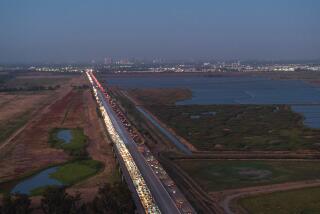Torrance’s crime map omits hundreds of violations
- Share via
There’s no place in Torrance more thick with thieves than the Del Amo Fashion Center, the city’s largest mall. But you wouldn’t know that if you looked at the crime map published on the city’s website.
Launched last year, the city’s map promised to use cutting-edge technology to notify residents of the latest crimes in their community. But a Times review has found that the Torrance Police Department deliberately withholds information on hundreds of crimes across the city, including some of the most serious.
More than 150 theft reports filed at the Del Amo mall in the months after the map launched are missing. So are eight rapes recorded by Torrance police and scores of other crimes that the department deems “confidential.”
Sgt. Jeremiah Hart, spokesman for the department, said crime information can be omitted from the map for a variety of reasons. For example, he said, officials don’t report shoplifting because they believe it is a “crime of opportunity” that doesn’t reflect a particular trend and is unrelated to personal safety. And, he said, such crimes occur so frequently that preparing them all for publication would require more staffing.
Hart said rape reports are omitted to protect the privacy of the victim.
“For us, it’s a balancing test,” Hart said. “Do we put it on a map for everybody to see and do we balance that against the privacy of the victim. We gave more weight to privacy of the victim for those crimes. That decision is rooted in one of our core values: compassion for those victims.”
Torrance’s map displays a block-number or the nearest intersection, rather than the precise address where a crime occurred — common practice on crime maps across the country, including many that publish rape reports.
Also withheld are crimes the department considers confidential, which include undercover operations, officer-involved shootings and internal investigations of police officers.
Torrance’s policy of withholding crime information on its website stands in contrast to the position of other agencies in the county, including the Los Angeles Police Department and the Los Angeles County Sheriff’s Department, which publish information on all major crimes online.
Hart said anyone can contact the department and request more complete crime data that isn’t on its website, including information about thefts or rapes.
After being contacted by The Times, the city released a statement saying the map was developed “based on [the] community’s involvement,” although officials acknowledge that no one outside government was consulted in the decision to withhold certain crimes.
Hart says that the crime map omissions are acceptable to the community.
“The intent of the police department is not to try to hide something,” he said.
Not everyone agrees.
“The average Joe Blow doesn’t know that this stuff is missing,” said John Bailey, president of the Southeast Torrance Homeowners’ Assn. and a frequent critic of City Hall. “I think that they should be on there. Then people would see. What if there are four rapes in one area? Then people would realize they need to avoid that area.”
The Times has requested an automated feed of Torrance crime data so it can integrate the city with latimes.com’s Crime L.A. database. The site already publishes reports from the LAPD and Sheriff’s Department, which police the majority of the county.
Both the LAPD and Sheriff’s Department disclose to The Times the major crimes that all large departments are required to send to the FBI. Torrance has provided The Times with the incomplete records it publishes on its crime map, which is limited to the last 45 days of activity. The city has so far declined to provide a complete, automated feed of the data that includes all reports sent to the FBI. The Torrance city attorney’s office is currently reviewing The Times’ request.
Times staff writers Sarah Ardalani and Abby Sewell contributed to this report.
More to Read
Sign up for Essential California
The most important California stories and recommendations in your inbox every morning.
You may occasionally receive promotional content from the Los Angeles Times.











